Body markings
The Drabardi donkey has two main categories of white pattering; spotted and roan. There are two varieties of spotted and three of roan, plus one special 'combination pattern' caused by an interaction between spotted + roan.
| # Spotted | # Roan | # Facial markings | # Leg markings |
SpottedSpotted is a dominant gene (Ss). The homozygous form (SS) is lethal. To get a spotted donkey one parent MUST be spotted. The spotted pattern in Drabardi donkeys looks visually closest to the overo pattern in horses. It also behaves similarly to overo from a genetic standpoint. One could describe the spots as being horizontally oriented, i.e. concentrated on the sides of the body, rather than starting from the belly or topline. Color generally remains visible around the eyes, ears, topline, and one or more legs. The leg markings may be broken or spotted. The spots cannot be small and round (like appaloosa spots). Spotting also covers the mane/tail. Spotting makes white facial and leg markings very loud, and skewed/off-centred markings are often observed (see the main 'white markings' section for more information). When a donkey has a big star or blaze and one or more white leg markings extending to the knee (see the top illustration) it is almost certainly exhibiting a minimal expression of spotted. There is a pattern of progression of Drabardi spotting from minimum to maximum, just as there is in paint horses.  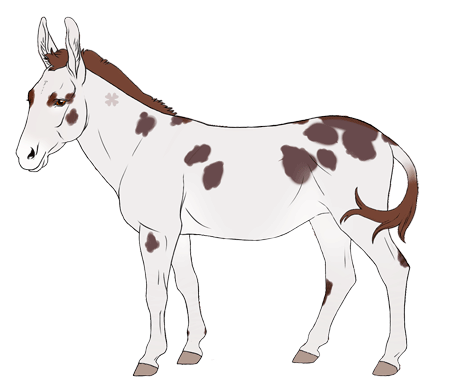 Left: Minimal spotted; a (broad) blaze and at least one or two white legs.
Right: An example of the maximum expression of spotted. There should be at least 20% of the base color still visible on the donkey. Sometimes a maximum expression of spotted can resemble the tyger pattern but it won't have as many of the small rounded spots that a tyger spotted has.
Left: Minimal spotted; a (broad) blaze and at least one or two white legs.
Right: An example of the maximum expression of spotted. There should be at least 20% of the base color still visible on the donkey. Sometimes a maximum expression of spotted can resemble the tyger pattern but it won't have as many of the small rounded spots that a tyger spotted has. |

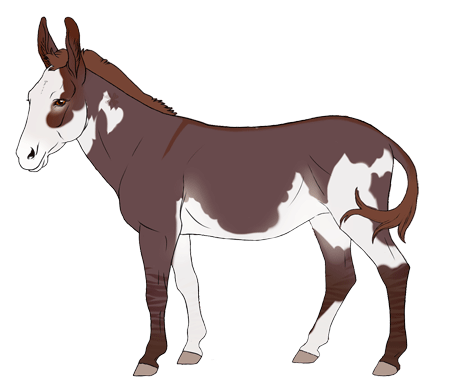 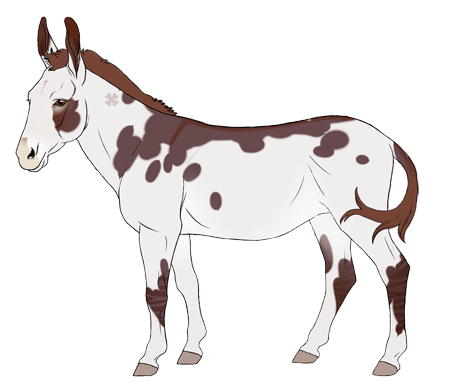 Above: Examples of Spotted donkeys Above: Examples of Spotted donkeys |
| MARKINGNAME: | Genotype: | Rarity: |
|---|---|---|
| SPOTTED - homozygous | SS | !!LETHAL!! |
| SPOTTED - heterozygous | Ss | Common |
TygerThe name most likely comes from the french word "tigre", even if the word itself conjures images of a striped cat instead a tyger donkey have spots. The body of a tyger Drabardi will often be creamy white and covered with small roundish spots. Tyger spots resemble leopard appaloosa to some degree. There is no such thing as an "appy Drabardi", but this is as close to it as you can get. A 'line' or concentration of colored spots tends to be somewhat 'symmetrical' and originate down the topline of a tyger donkey. It's also common to see a colored patch around the eyes and around the ears. At times a tyger spotted Drabardi can look like a maximum spotted donkey, however normal spotted markings won't be as small or round as tyger ones. The edges of the tyger spots can be either crisp or slightly roaned. There might be a few stray spots on the lower parts of the body (must be kept minimal!), but the legs can't be covered in big patches of color like a normal spotted donkey. Even though there is no genetic connection, tyger is also similar to horse leopard patterning in the way that it causes a distinct set of characteristics: - Mottled, speckled or blotchy skin (pink or flesh-colored) around the donkey's muzzle, eyes, genitalia and anus - Striped hooves - White sclera (like human eye white) Since the tyger spotted donkey also carries the normal spotted gene it is very likely you will just get a normal spotted foal when you breed from them. A normal (Ss) spotted donkey will NOT display any of these tyger characteristics (unless carrying the Chardonnai or Ivorie gene). 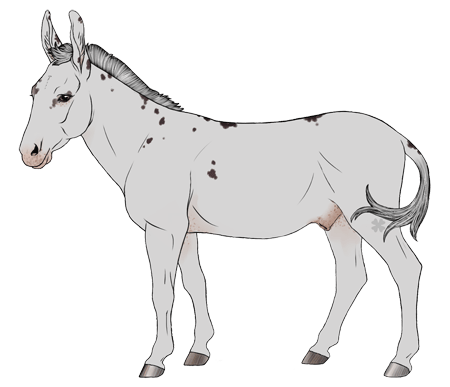 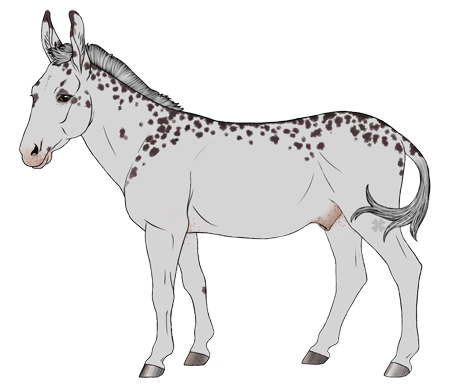 These are examples of tyger spotted Drabardis. The white areas should cover at least 80% of the body, and there needs to be at least 10 spots somewhere on the donkey.
These are examples of tyger spotted Drabardis. The white areas should cover at least 80% of the body, and there needs to be at least 10 spots somewhere on the donkey. |
| INFORMATION: | Genotype: | Rarity: |
|---|---|---|
| SPOTTED - Tyger | Ss+T | Very Rare |
Don't forget - The Drabardi hues range from 15-70% in opacity. The high opacity hues are very rare!